 W
WAdeona is a genus of bryozoans in the family Adeonidae. A typical example is the Australian species Adeona cellulosa that forms large colonies with bifoliate sheets containing numerous holes (fenestrae).
 W
WThe Adeonidae is a family within the bryozoan order Cheilostomata. Colonies are often upright bilaminar branches or sheets, perforated by large holes in some species. The zooids generally have one or more adventitious avicularia on their frontal wall. Instead of ovicells the adeonids often possess enlarged polymorphs which brood the larvae internally.
 W
WAlcyonidium is a genus of bryozoans in the order Ctenostomata.
 W
WAlcyonidium diaphanum, commonly called the sea-chervil, is a species of bryozoan found in the North Atlantic. It can cause a rash known as "Dogger Bank itch" when handled for prolonged periods.
 W
WAmplexopora is a genus of bryozoans known in the rock record from the Ordovician to the Permian periods. Species belonging to this genus were stationary epifaunal suspension feeders.
 W
WAscophora is an infraorder under order Cheilostomata of the Bryozoa.
 W
WThe Bitectiporidae is a family within the bryozoan order Cheilostomata. Colonies are encrusting on shells and rocks or upright bilaminar branches or sheets. The zooids generally have at least one adventitious avicularia on their frontal wall near the orifice. The frontal wall is usually covered with small pores and numerous larger pores along the margin. The ovicell, which broods the larvae internally, is double-layered with numerous pores in the outer layer, and sits quite prominently on the frontal wall of the next zooid.
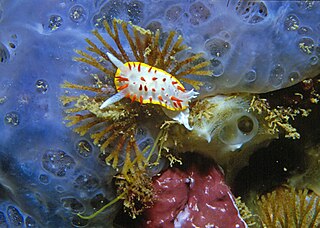 W
WBugula neritina is a cryptic species complex of sessile marine animal in the genus Bugula.
 W
WCatenicella are a genus of bryozoans in the family Catenicellidae.
 W
WThe Catenicellidae are a family of bryozoans in the suborder Ascophora.
 W
WThe Celleporidae is a family within the bryozoan order Cheilostomata.
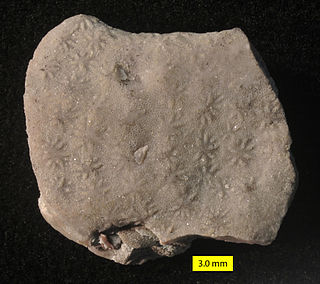 W
WConstellaria is an extinct genus of bryozoan from the Ordovician.
 W
WCrepipora is an extinct genus of marine bryozoans belonging to the Ceramoporidae family. There are currently 18 collections from Belarus, Sweden, Canada, France and the United States. It was first assigned to Cystoporata by Sepkoski in 2002. The fossil range is from the Middle Ordovician to the Upper Ordovician.
 W
WCristatella mucedo is a bryozoan in the family Cristatellidae, and the only species of the genus Cristatella. They are noted for their elongated shape and colorless, transparent bodies.
 W
WThe Ctenostomata are an order of bryozoans in the class Gymnolaemata. The great majority of ctenostome species are marine, although Paludicella inhabits freshwater. They are distinguished from their close relatives, the cheilostomes, by their lack of a calcified exoskeleton. Instead, the exoskeleton is chitinous, gelatinous, or composed only of a soft membrane, and always lacks an operculum. Colonies of ctenostomes are often composed of elongated, branch-like stolons, although more compact forms also exist.
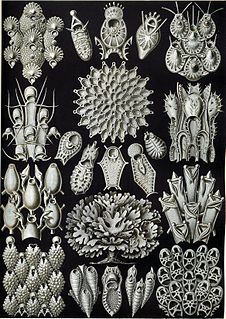 W
WCupuladria is a genus of bryozoans in the suborder Flustrina.
 W
WA cyphonautes is a larva of an ectoproct or bryozoan. It is triangular in profile with a heavily-ciliated band called the corona at the base of the triangle and a sense organ at the apex. The beating of coronal cilia propels the cyphonautes through the water and contributes to a feeding current. The cyphonautes is very thin, i.e. laterally compressed, and is bounded laterally by two valves or shell plates. The internal anatomy of the archetypical cyphonautes, such as the one featured in the life cycles of Membranipora, includes a complete digestive tract with a stomach entrance near the apex and a hindgut ending in an anus near one end of the base. At the other end of the triangle's base is the pyriform organ, a heavily ciliated and glandular complex that functions in site selection at settlement.
 W
WCystoporida is an extinct order of bryozoans in the class Stenolaemata.
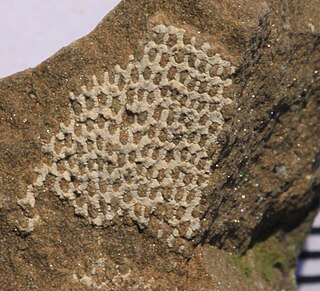 W
WFenestellidae is a family of Bryozoans belonging to the order Fenestrida. The skeleton of its colonies consists of stiff branches that are interconnected by narrower crossbars. The individuals of the colony inhabit one side of the branches in two parallel rows or two at the branch base and three or more rows further up. Zooids can be recognized as small rimmed pores, and in well-preserved specimens the apertures are closed by centrally perforated lids. The front of the branches carries small nodes in a row or zigzag line between the apertures. Branches split from time to time giving the colonies a fan-shape or, in the genus Archimedes, create an mesh in the shape of an Archimedes screw.
 W
WFenestrulina is a genus within the bryozoan order Cheilostomata. It is the only member of the family Fenestrulinidae.
 W
WFlustrellidra hispida is a species of colonial bryozoan in the order Ctenostomatida.
 W
WFlustridae is a family of bryozoans in the suborder Flustrina.
 W
WFlustrina is a suborder under the order Cheilostomatida of gymnolaematan Bryozoa.
 W
WGymnolaemata are a class of Bryozoans. Gymnolaemata are sessile, mostly marine organisms and grow on the surfaces of rocks, kelp, and in some cases on animals, like fish. Zooids are cylindrical or flattened. The lophophore is protruded by action of muscles pulling on the frontal wall. This order includes the majority of living bryozoan species.
 W
WHallopora is an extinct genus of bryozoans. They can be found in Ohio, Indiana, and Kentucky of the Midwestern United States, commonly in the Ordovician Kope Formation.
 W
WHeterotrypidae is an extinct bryozoan family in the order Trepostomata.
 W
WMalacostegina is a sub-order of marine, colonial bryozoans in the order Cheilostomatida. The structure of the individual zooids is generally simple, with an uncalcified, flexible frontal wall. This sub-order includes the earliest known cheilostome, in the genus Pyriporopsis (Electridae).
 W
WMembranipora is a genus of bryozoans in the family Membraniporidae. A typical example is the widely distributed species Membranipora membranacea that commonly encrusts seaweeds, particularly fronds of the kelps Laminaria digitata, L. hyperborea, and Saccorhiza polyschides.
 W
WThe Microporellidae is a family within the bryozoan order Cheilostomata.
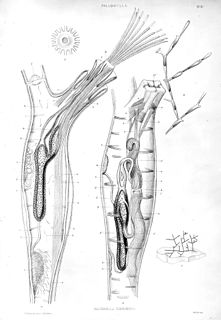 W
WPaludicella is a genus of freshwater bryozoans in the family Paludicellidae.
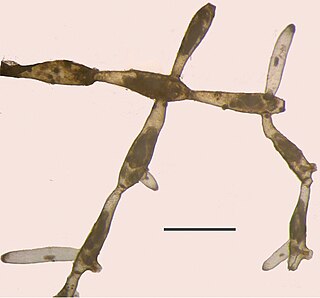 W
WPaludicella articulata is a species of freshwater moss animal in the genus Paludicella.
 W
WPectinatella magnifica, the magnificent bryozoan, is a member of the Bryozoa phylum, in the order Plumatellida. It is a colony of organisms that bind together; these colonies can sometimes be 60 centimeters in diameter. These organisms can be found mostly in North America with some in Europe. They are often found attached to objects, but can be found free floating as well. They form a translucent body with many star-like blooms along the outside. The density of the organism is similar to that of gelatin, and is easily breakable into smaller chunks.
 W
WPlumatella is a genus of bryozoans from Plumatellidae family.
 W
WPlumatella fungosa is a species of bryozoans from the family Plumatellidae.
 W
WReteporella is a genus of bryozoans in the family Phidoloporidae.
 W
WReteporella grimaldii is a species of bryozoans in the family Phidoloporidae.
 W
WSchizoporella is a genus of bryozoans in the family Schizoporellidae.
 W
WSchizoporella unicornis is a species of bryozoans in the family Schizoporellidae.
 W
WThe Schizoporellidae is a family within the bryozoan order Cheilostomata. Colonies are encrusting on shells and rocks or upright bilaminar branches or sheets. The zooidal orifice has a narrow V-shaped sinus.
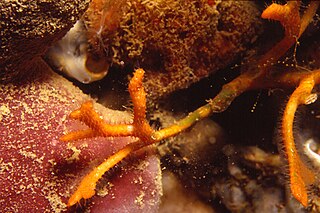 W
WThe Smittinidae is a family within the bryozoan order Cheilostomata. Colonies are encrusting on shells and rocks or upright bilaminar branches or sheets. The zooids generally have at least one adventitious avicularia on their frontal wall near the orifice. The frontal wall is usually covered with small pores and numerous larger pores along the margin. The ovicell, which broods the larvae internally, is double-layered with numerous pores in the outer layer, and sits quite prominently on the frontal wall of the next zooid.
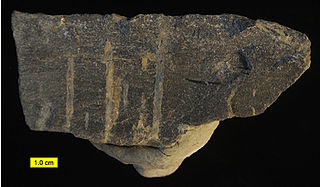 W
WStigmatella is an extinct genus of bryozoans in the family Heterotrypidae.
 W
WThe Stomachetosellidae is a family within the bryozoan order Cheilostomata. Colonies are encrusting on shells and rocks or upright bilaminar branches or sheets. The zooids generally have at least one adventitious avicularia on their frontal wall near the orifice. The frontal wall is usually covered with small pores and numerous larger pores along the margin. The ovicell, which broods the larvae internally, is double-layered with numerous pores in the outer layer, and sits quite prominently on the frontal wall of the next zooid.
 W
WTrepostomata is an extinct order of bryozoans in the class Stenolaemata.
 W
WTriphyllozoon is a genus of bryozoans in the family Phidoloporidae.
 W
WTriphyllozoon inornatum is a species of bryozoa in the family Phidoloporidae.
 W
WTubuliporina is a suborder of bryozoans in the order Cyclostomatida. The earliest possible crown-group fossil date to the upper Triassic.